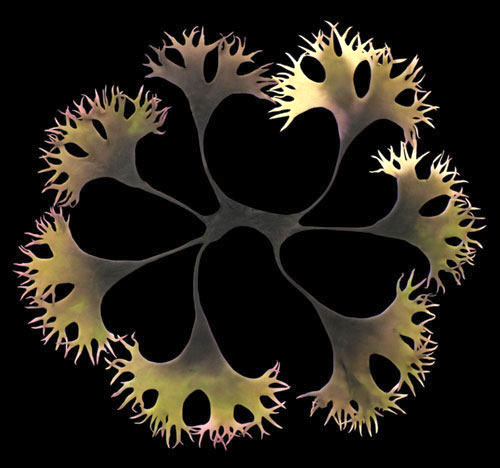Found Objects
By Felice Frankel
The creator of an award-winning digital photograph of the seaweed Chondrus crispus discusses imaging of herbarium collections and the process by which this particular image was made
The creator of an award-winning digital photograph of the seaweed Chondrus crispus discusses imaging of herbarium collections and the process by which this particular image was made

DOI: 10.1511/2007.68.526
In my fifth and final year as a judge for the annual Science and Engineering Visualization Challenge sponsored by the National Science Foundation and the journal Science, I once again wanted to share one particular winner with Sightings readers. Call me old-fashioned, but I still think a stunningly beautiful image, wondrous, mysterious and meticulously executed, can cross all barriers of education, background and discipline—so that even an exhausted group of judges, at the end of a full day of judging hundreds of submissions, can still sit back, pause, smile and agree: "We have a winner." I asked Andrea Ottesen, the creator of this photograph of a seaweed, a few questions. Andrea is a doctoral candidate and graduate research assistant in the Department of Plant Sciences and Landscape Architecture at the University of Maryland.

Andrea Ottesen
F.F. Andrea, I'm interested in how you found this particular specimen and how you transported it to photograph it. And why this particular one?
A.O. I am constantly cataloguing species wherever I go. I am completely fascinated by (in love with!) plants, and I can't escape the desire to know who is who. I studied taxonomy with the ethnobotanist and herbalist Jim Duke and at the U.S. National Arboretum. I went on my first plant collecting expedition with Duke in 1997 to Peru, where we collected Amazonian medicinal plants.
My recent Ph.D. thesis work with the molecular ecology of organic vs. conventionally managed crops started me thinking about seaweeds! We use kelp as a fertilizer—as a source of nitrogen—for the organic plots. There has also been some recent literature about using seaweeds as biofuels. Some would obviously be better fertilizers or biofuel sources.
I fished this little Chondrus crispus out of the sea off the coast of Cape Breton, Nova Scotia, last summer. A part of any herbarium collection work is, of course, to press the specimen and dry it. A fairly recent addition to this protocol has been to photograph the specimen and make the image available to research and public interests. Most herbaria have already digitized and placed images of their most valuable specimens online for public use. After working for the National Arboretum and creating a Web site to display their digitized specimens, I started imaging all my herbarium collections.
F.F. Tell us how you photographed it. Were there any special technical problems?
A.O. My little seaweed, once pressed, was photographed outside, where I often get the best lighting. I set up an indoor lighting system, but truthfully, if it's the right light outside, I prefer the natural colors and the magical light that can sometimes come through the specimen. This specimen was photographed outside in the sunlight.
F.F. Did you perform any sort of digital manipulation? It looks amazingly perfect.
A.O. I don't feel that the seaweed itself is manipulated; I am always true to the organisms. It was, however, "cut out" to place it on a background that would accentuate the form. I cut the stalk with scissors as I was doing the shoot as well.
Click "American Scientist" to access home page
American Scientist Comments and Discussion
To discuss our articles or comment on them, please share them and tag American Scientist on social media platforms. Here are links to our profiles on Twitter, Facebook, and LinkedIn.
If we re-share your post, we will moderate comments/discussion following our comments policy.